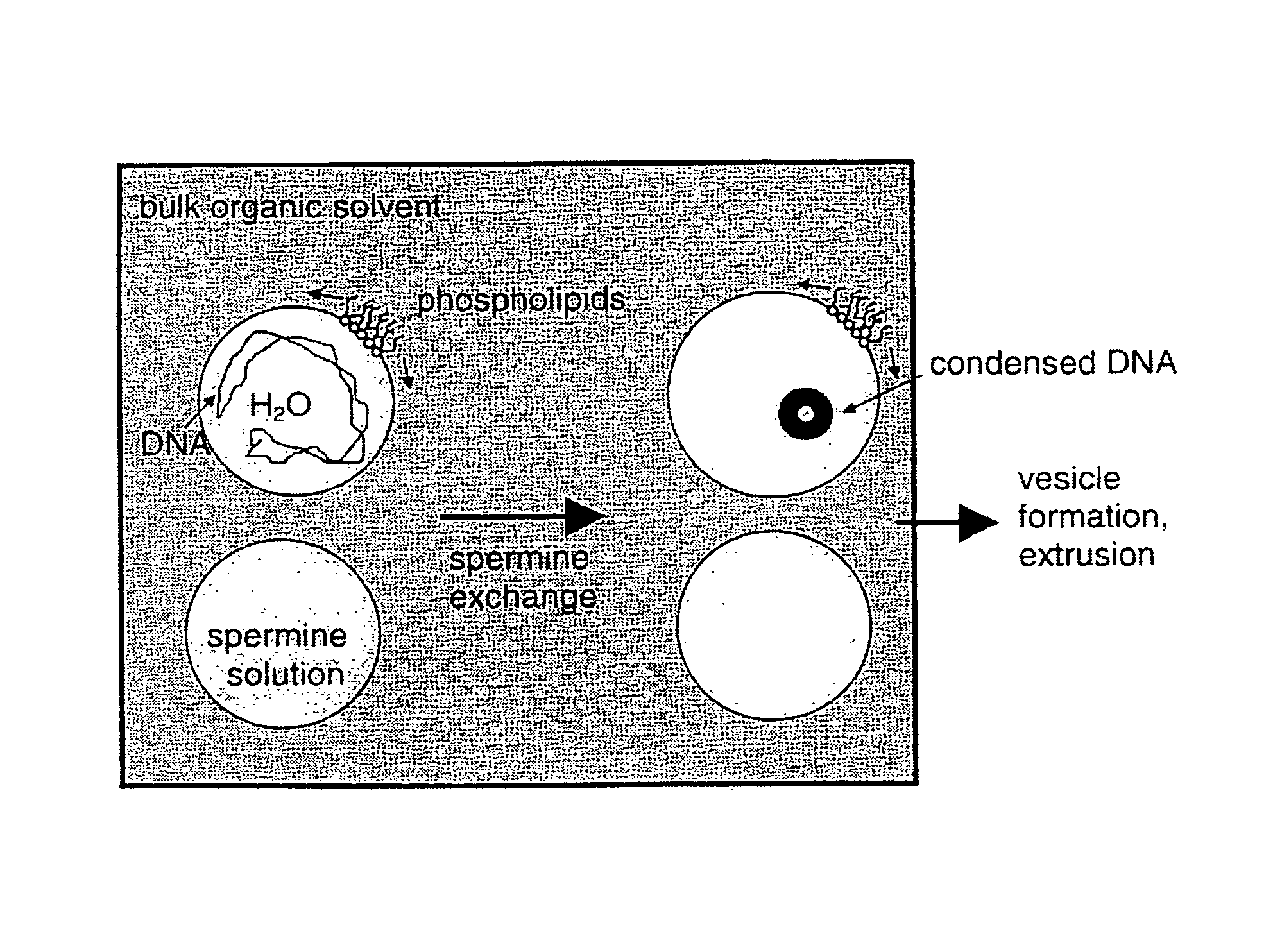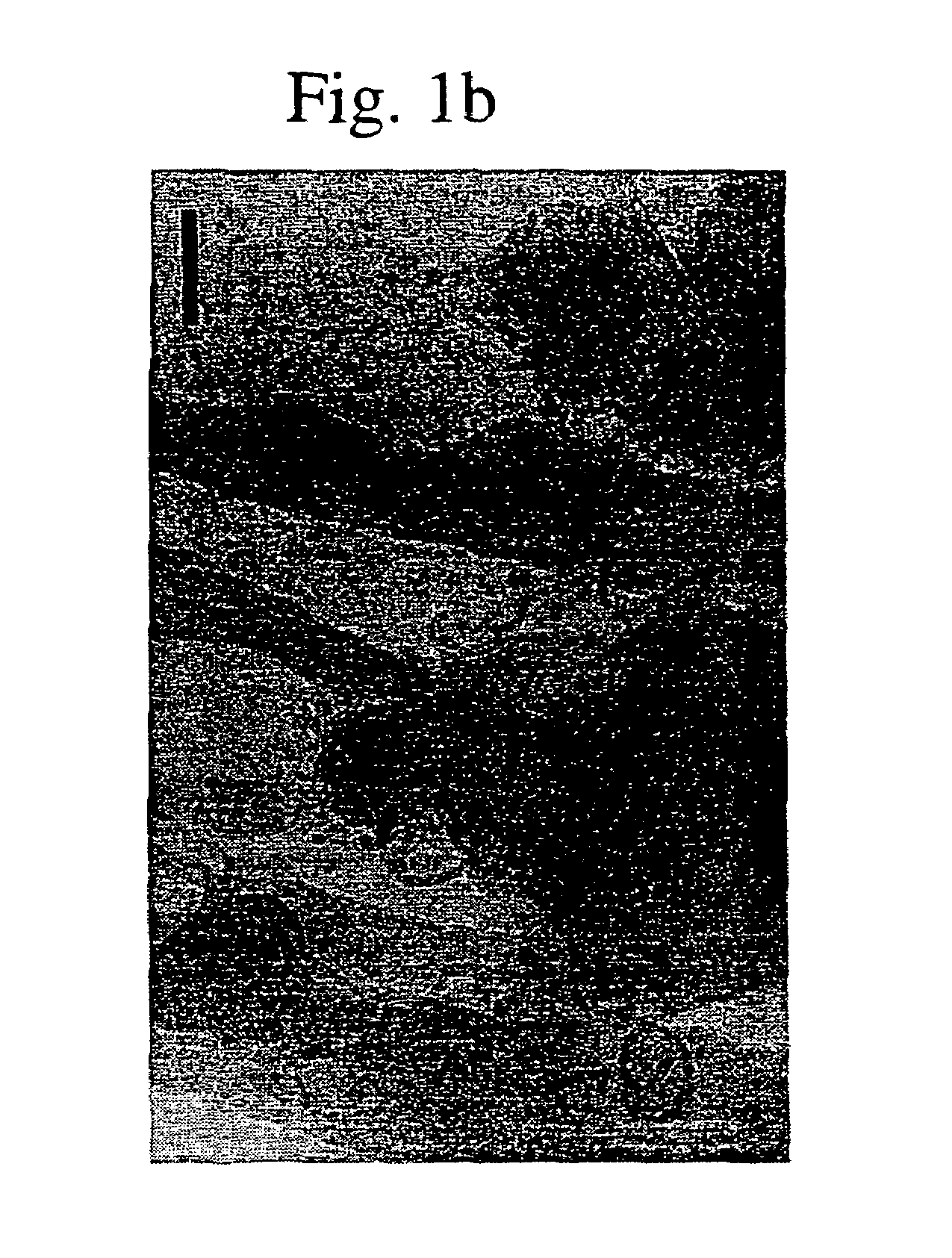Encapsulation of bioactive complexes in liposomes
a bioactive complex and liposome technology, applied in the field of liposome encapsulation, can solve the problems of complexed bioactive agents entering the liposome, and achieve the effects of less likely, high ratio of bioactive agent-to-lipid ratio, and efficacy
- Summary
- Abstract
- Description
- Claims
- Application Information
AI Technical Summary
Benefits of technology
Problems solved by technology
Method used
Image
Examples
example 1
Materials
[0102]N-(lissamine rhodamine B sulfonyl)-phosphatidylethanolamine (transesterified from egg PC), DOPC, EPC and N-C12-DOPE were purchased from Avanti Polar Lipids (Alabaster, Ala.). OVCAR3 ovarian carcinoma cells were purchased from NCI-Frederick Cancer Research Laboratory (Frederick, Md.). The pEGFP-C1 plasmid, and E. coli DH5α competent cells were purchased from Clontech Laboratories (Palo Alto, Calif.). pZeoSVLacZ plasmid, competent cells and Hanahan's S.O.C. were purchased from Invitrogen (San Diego, Calif.). Hanks Balanced Salt Solution (HBSS), RPMI 1640 and heat inactivated fetal bovine serum and Lipofectin were purchased from Gibco / BRL (Grand Island, N.Y.). DNase-free RNase and RNase-free DNase I were purchased from Boehringer Mannheim (GmbH, Germany). Agarose was purchased from FMC Bioproducts (Rockland, Me.). Bacto agar, Bacto tryptone and yeast extract were purchased from DIFCO Laboratories (Detroit, Mich.). Calcein blue acetoxy methyl ester (CBAM), PicoGreen and S...
example 2
Plasmid Purification
[0103]Two plasmids were used in this study: the pZeoSVLacZ plasmid which is 6.5 kb, and expresses the lacZ gene for β-galactosidase in mammalian cells from the SV40 early enhancer-promoter, allowing selection in mammalian cells and E. coli using the antibiotic zeocin; and, the pEGFP-C1 plasmid, which is 4.7 kb and expresses enhanced green fluorescent protein (EGFP) from a human cytomegalovirus immediate early promoter, allowing selection in E. coli using kanamycin, and in mammalian cells using G418. Plasmids were purified from E. Coli (Baumann and Bloomfield, Biotechniques, 19: 884-890 (1995))—the final ratio of O.D. at 260 nm to O.D. at 280 nm was greater than 1.9 for all preparations; agarose gel electrophoresis indicated DNA in the expected size range.
example 3
Liposomal-DNA Formulations
[0104]Samples were prepared by diluting 200 μg of DNA into 125 μl of LSB, and then combining the resulting suspension with 1 ml CHCl3 containing 30 μmole of 70:30 molar ratio of N-C12 DOPE and DOPC, in a 13×100 Pyrex tube while vortexing. The sample was immediately sonicated for 12 seconds in a bath sonicator (Laboratory Supplies Co. Hicksville, N.Y.) under maximum power, to form an emulsion with plasmid DNA first. Subsequently, a 125 μl aliquot of LSB containing various concentrations of spermine (16 to 40 millimolar) was added to this emulsion with vortexing and sonication. Samples without spermine were prepared in the same way, except that spermine was omitted from the second 125 μl aliquot. Preparation of the samples with EPC was also identical, except that 7 mM spermine used.
[0105]Resulting emulsions were placed, within a few minutes, in a flask on a Rotovap (Büchi Laboratoriums-Technik AG, Switzerland). Organic solvent was removed while rotating the f...
PUM
 Login to View More
Login to View More Abstract
Description
Claims
Application Information
 Login to View More
Login to View More - R&D
- Intellectual Property
- Life Sciences
- Materials
- Tech Scout
- Unparalleled Data Quality
- Higher Quality Content
- 60% Fewer Hallucinations
Browse by: Latest US Patents, China's latest patents, Technical Efficacy Thesaurus, Application Domain, Technology Topic, Popular Technical Reports.
© 2025 PatSnap. All rights reserved.Legal|Privacy policy|Modern Slavery Act Transparency Statement|Sitemap|About US| Contact US: help@patsnap.com



